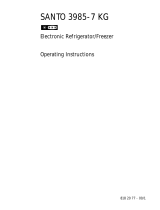
Safety
40
• Before disposing of old appliances make them inoperable. Remove
plug from mains, sever the power cable, remove or destroy any snap
or latch closures. This eliminates the danger that playing children lock
themselves into the appliance (danger of suffocation!) or place them-
selves into other life-endangering situations.
• Children often do not recognise the dangers involved with household
appliances. Please provide for the necessary supervision and do not
allow children to play with the appliance!
Daily Operation
• Containers with flammable gases or fluids can develop leaks through
contact with the cold. Danger of explosion! Do not store containers
with flammable substances, such as aerosol cans, refill cartridges for
cigarette lighters etc. in the refrigerator/freezer.
• Bottles and cans may not be placed in the freezer compartment. They
can burst when the contents freeze - or even explode if the contents
contain carbonic acid! Never place sodas, juices, beer, wine, champa-
gne etc. into the freezer compartment. Exception: Spirits with high
alcohol content may be stored in the freezer compartment.
• Do not place ice cream or ice cubes directly from the freezer com-
partment into the mouth. Very cold ice can freeze to the lips or ton-
gue and cause injury.
• Never touch frozen goods with wet hands. Hands can freeze to the
goods.
• Warning - Do not operate any electrical appliances in the appliance
(e.g. electric ice cream makers, mixers etc.) unless they have been
authorised by the manufacturer.
• Warning - In order not to impair the function of the appliance, never
cover or obstruct the ventilation openings.
• Warning - Do not use any mechanical devices or other artificial
means to speed up defrosting unless they are recommended by the
manufacturer.
• Before cleaning the appliance switch off and remove the plug from
the mains, or switch off or turn out the circuit breaker or fuse.
• Placing frozen goods on the top of the appliance can lead to the
accumulation of condensate in the cavity of the storage tray through
contact with the cold. Electronic components are housed within this
cavity. If condensate should drip onto these components, the
appliance could be damaged by a short circuit. For this reason do not
place frozen goods on top of the appliance.




















